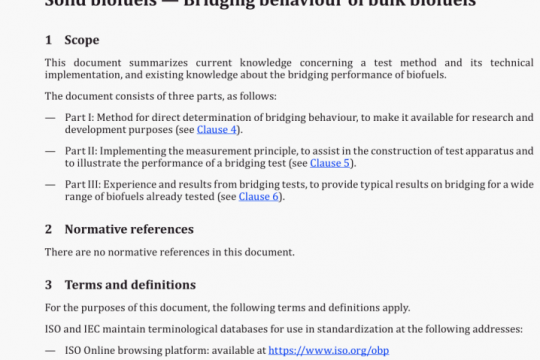ISO 17076-1 pdf free download
ISO 17076-1-2020 pdf free download.Leather – Determination of abrasion resistance一 Part 1: TaberR method.
7 Procedure
7.1 Preparation of abrasive wheels
7.1.1 Prepare rubber-based abrasive wheels (CS series) using the procedure in LL to LL. Prepare tungsten carbide (‘S” series) abrasive wheels using the procedure In L..L9. Prepare silicon carbide wheels (NH” series) using the procedure in 7.1.10 to 7.1.12.
7.1.2 Fit the rubber-based abrasive wheels to the pivoted arms (5.1), ensuring that the wheels are mounted on the correct arm with the labels facing towards the centre of the test piece holder.
7.1.3 Fit the additional weights (52) to give a loading of (9,8 ± 0,4) N on each abrasive wheel.
7.1.4 Fit a piece of abrasive paper (5dQ) to the test piece holder.
7.1.5 Lower the abrasive wheels onto the surface of the abrasive paper. turn on the vacuum (i9). switch on the machine and run for 20 cycles.
7.1.6 Replace the abrasive paper with a new piece of abrasive paper and repeat LLS.
7.1.7 Examine the abrasive wheels. lithe colour is not uniform, repeat the abrasive preparation with a fresh piece of abrasive paper. If the colour is still not uniform, discard the wheels.
7.1.8 Brush the wheels with a soft brush or use compressed air (5.11) to remove any debris.
Optionally, the preparation of rubber-based abrasive wheels can be performed by using the procedure in 7.1.11 to 7.1.12.
7.1.9 Prepare tungsten carbide wheels by brushing with a stiff bristle brush (5.12) to remove any loose particles.
7.1.10 Prepare silicon carbide abrasive wheels by using a diamond re-facing tool (5.1.5).
7.1.11 Traverse the tip of the diamond re-facing tool across the face of each wheel so that a double traverse (i.e. one forward and one backward movement) takes 25 s. Apply the minimum force necessary to the wheel by the diamond re-facing tool to produce an effective preparation.
7.1.12 Brush the wheels with a stiff bristle brush (5.12) or use compressed air (5JJ) to remove any loose particles.
7.2 Abrasion of test pieces
7.2.1 Fit the prepared abrasive wheels (Li) or reconditioned abrasive wheels (2.1) to the pivoted arms (5.1), ensuring that the wheels are mounted on the correct arm with the labels facing towards the centre of the test piece holder.
7.2.2 Select the weights (51) to give a loading of either (2,5 ± 0,1) N (no additional weight), (4,9 ± 0,2) N or (9.8 ± 0,4) N on each abrasive wheel. The weight used is recorded in the test report [7 c)J.
NOTE Generally, an additional weight of(4,9 ± 0,2) N is used, but the client will specify the weight to be used.
7.2.3 Fit a prepared and mounted test piece (fil) to the test piece holder.
7.2.4 Lower the abrasive wheels onto the test piece, turn on the vacuum (5.9). switch on the machine and run for the specified number of cycles.
7.2.5 Stop the machine and remove the test piece. Examine the test piece visually and by using the magnifier (514), and record any damage excluding any damage 2 mm from the edge of the tested area or in depressed areas caused by starting or stopping the machine. If required, use the grey scale (513) to determine the colour change of the tested area.
7.2.6 Replace the test piece and continue the abrasion to the next specified number of cycles. Repeat 72.5.
7.2.7 Repeat Z.2ii for any other number of cycles given in ZZA.
7.3 Reconditioning of abrasive wheels
7.3.1 Recondition rubber-based abrasive wheels (“CS” series) using the procedure in LIZ to L3..51. Recondition tungsten carbide abrasive wheels (“S” series) using the procedure in L16. Recondition silicon carbide wheels (RH” series) using the procedure An LIZ to 7.1.9.
7.3.2 Prior to each test recondition rubber-based abrasive wheels. Tungsten and silicon wheels should be reconditioned as deemed necessary.
7.3.3 Repeat 21.3 to 21.5.
7.3.4 Brush the wheels with a soft brush 15.1 11 to remove any debris.ISO 17076-1 pdf download.




